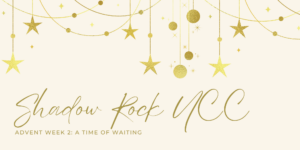
Advent is a season in which we crank up our usual level of intentionality around worship planning. What I mean is that we are typically intentional about worship. One of the hallmarks of our congregational culture is a sense of compassion and purpose around the language that we use, especially the language of Spirit and ultimate reality.
To put it plainly: we choose our spiritual words very carefully, all year round.
In Advent, we feel this typical weight of our usual care around words and God even more.
One of the goals of Advent worship is to find a way to breathe new life into a really old story: God breaking into the world through the birth of a child. In the wide metanarrative of Christian experience, we have most often described this story as light coming into the darkness.
This is a beautiful metaphor… for this dark time of the year, at least for those of us in the northern hemisphere.
This is a beautiful metaphor… for the ways that it describes the human heart.
This is a beautiful metaphor… for the lights on the tree and the star and the candles.
But this metaphor – this framing of the Christmas story as light versus darkness – it reinforces our implicit biases. Learn more about and test your own biases here: Harvard Implicit Bias Site.
Besides keeping us stuck in our bias, over-reliance on the light/darkness metaphor hurts our beloved siblings of African descent. EVEN IF WE DON’T UNDERSTAND THIS PAIN, our values of inclusion and justice call us to respond with love.
Some other framing metaphors for the Advent and Christmas seasons that you might hear this year include
… moving from loss to wholeness, feeling lost to feeling found
… getting to know our own and others’ complexity
… traveling out of bondage into freedom
… healing: the way we might stop feeling “stuck” and begin to see new possibilities
… wholeness and worthiness
… embracing hope and its messy consequences
In Advent 2022, we’ll also be re-visiting a foundational practice for our fellowship. Sometimes we call it ORID (Observe, Reflect, Interpret, Decide). It’s also called Art Form Discussion or Focused Conversation. Beginning in observation, being grounded in our sensory experiences, helps us slow our minds. Clarity becomes possible.
We embrace this season of intentionality. Be encouraged and of good cheer! God is with us.
